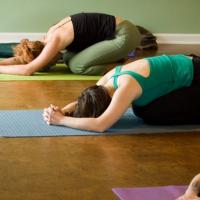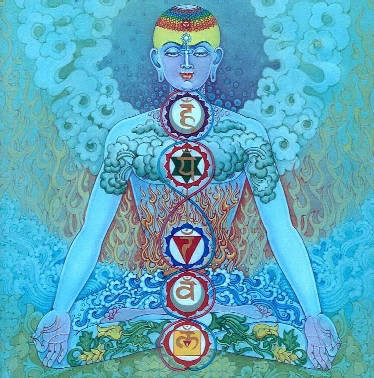 |
 |
|
 Practiced
for over 5,000 years, nearly 11 million Americans today are yoga devotees. Yoga
practitioners enjoy a host of physical, mental, and spiritual benefits that
keep them coming back for more. These benefits can be experienced by beginners
after their first class. And with all the different styles of yoga that now
exist, yoga is truly for everyone, even those who think they're not flexible
enough, too old, or not fit enough to move their bodies through the asanas.
Yoga can improve the strength, endurance, and flexibility of anyone who
practices it, in addition to the mental and emotional health benefits that come
from regular exercise. Practiced
for over 5,000 years, nearly 11 million Americans today are yoga devotees. Yoga
practitioners enjoy a host of physical, mental, and spiritual benefits that
keep them coming back for more. These benefits can be experienced by beginners
after their first class. And with all the different styles of yoga that now
exist, yoga is truly for everyone, even those who think they're not flexible
enough, too old, or not fit enough to move their bodies through the asanas.
Yoga can improve the strength, endurance, and flexibility of anyone who
practices it, in addition to the mental and emotional health benefits that come
from regular exercise.
Many yoga practitioners think of the health benefits of a regular yoga practice
as merely a positive "side effect," to the harmony of the body and
mind brought about during yoga. And for many yoga devotees this creates a sense
of bliss they leave the class with and carry around with them. This is a kind
of mental detoxification that parallels the physical detoxification that also
happens during yoga. As a yogi glides through the asanas, they're massaging
internal glands and organs thoroughly and in a way that no other type of
physical activity accomplishes. This floods the body with nutrient-rich blood
that flushes out toxins in nearly every nook and cranny, all while nourishing
every part of the body. This stimulation and massage prevents disease and
creates a hyper-sensitivity and body awareness that allows some yogis to sense
a health problem at early onset.
Heart health pioneer Dr. Dean Ornish used yoga as a prominent part of his study
to improve cardiovascular health without surgery. His studies found that yoga
lowered blood pressure and slowed down the heart rate, helping people with
hypertension, heart disease, and those at risk for stroke. He also found that a
regular yoga practice decreased triglycerides and cholesterol, improved immune
system function, and perhaps even provided an antioxidant effect.
Anyone who's discovered the self-awareness and personal and physical strength
that's often found on the yoga mat knows that the benefits of yoga are many,
and some are hard to measure scientifically, or even put into words. But more
studies are increasing showing that this ancient practice is calming,
restoring, and helps to center the yogi away from the #1 killer in America...
stress.
|
|
 |
 |
|
In
the same way that yoga is good for men, women, and children from all walks of
life, yoga is great for teens, too. At a time when their bodies are changing
and teens of both genders may struggle with body image issues, yoga fosters a
body acceptance that helps build self-confidence and a healthy body image.
Adolescent boys like the way that a regular yoga practice builds muscle, while
teen girls appreciate the grace and poise that can result from a regular yoga
practice. Yoga can create yoga devotees out of even the most unlikely
prospects, especially when they grow to love the way yoga makes them look and
feel. And because no one can do every asana perfectly, yoga encourages and supports
individuality.Yoga can help soothe menstrual cramps, clear energy blocks that
can lead to headaches, irritability, digestive problems, and more. And because
yoga soothes tight muscles, tendons, and ligaments, yoga can help with growing
pains that plague many teens. Even better, many yoga practitioners believe that
the adolescent to later teen years are a time when the chakras are developing
and becoming more active within the body. Imbalances in the chakras can
manifest themselves in mood swings, rebellion, and a myriad of other negative
energies that are stereotypically associated with the teenage years. With a
regular yoga practice the chakras are more likely to stay in balance, keeping
the body and spirit strong and healthy.

The teenage years are a time of physical, emotional, and mental growth and
change, but yoga cultivates a sense of calm in teenage practitioners at a time
when many aspects of their lives are stressful and tumultuous. Stress from
academics, romantic relationships, friendships, and family pressures can
accumulate a host of negative energy in teens, but yoga promotes a sense of
calm and an emotional awareness that often results in a more peaceful
disposition and generally positive outlook. The focus on deliberate movement
quiets the mind, leaving little room for self-consciousness or worry. Mentally
balanced teens are happier teens, and this positivity often translates to
increased academic success and more stability in their relationships. Parents
will enjoy the fact that their yoga-centered teenagers are more capable of
dealing with the stresses that plague their peers, so the whole family will
benefit from the yoga.
A love of yoga developed during childhood or the teenage years can begin
growing a healthy habit of physical activity that will prove beneficial for
years to come. Whether yoga is practiced alone or in addition to other physical
activity, yoga helps build strength, endurance, and flexibility. In fact,
yoga's emphasis on flexibility is an aspect missing from many sports, so even
teen athletes can benefit from adding some yoga poses to their athletic
repertoire. As yoga poses strengthen and lengthen muscles, they'll help
to improve overall strength and balance, too, as well as lessening the
likelihood of an injury during athletic practice or competition.
And, at a time when obesity rates among teens are skyrocketing by the year,
yoga can even help teens slim down. A 2006 WebMD study of 60 high schoolers
found that after four days practice per week for three months, the study's
participants lost an average of six pounds and even reduced their Body Mass
Index. The breathing exercises they learned in yoga also helped the students in
other areas of their lives, including enhanced concentration and athletic,
musical, and public speaking performances, among others.
|
|
 |
 |
|
 If
you're seeking balance in your hectic life, you're not alone. Between work, family
obligations and everything else the typical person has going on, fitting in a
regular yoga practice can seem like an impossibility. But it's in the times you
think you don't have time for yoga that you usually need it the most, a time
just for yourself to focus and concentrate on moving your body and your mind
through the poses. Anyone who's ever stepped on a yoga mat during a busy day
knows that this time- even if it's borrowed- is well spent. It relaxes,
rejuvenates, and centers, recharging you for the rest of your day. If
you're seeking balance in your hectic life, you're not alone. Between work, family
obligations and everything else the typical person has going on, fitting in a
regular yoga practice can seem like an impossibility. But it's in the times you
think you don't have time for yoga that you usually need it the most, a time
just for yourself to focus and concentrate on moving your body and your mind
through the poses. Anyone who's ever stepped on a yoga mat during a busy day
knows that this time- even if it's borrowed- is well spent. It relaxes,
rejuvenates, and centers, recharging you for the rest of your day.
The beauty and ultimate goal of yoga is that practitioners are able to
reach a point where they're able to call upon the peace they find on their mat
at any moment, and in every moment. In the yogic tradition there are two ways
by which an individual may reach this state of calm and bliss. The first
model is known as the yogi renunciate, perhaps isolated in a cave or standing
on a mountaintop, completely removed from the busyness of the everyday. It is
in this isolation that the yogi is able to find clarity and peace. The second
model is of the yogic warrior, passionate and engaged in the world yet
completely committed and dedicated to the well-being of others. This yogi never
rests until their fellow beings are content and at peace, and adapts their
circumstances so they're able to find their own peace even among the most
severe external chaos. Most yogis should try and find a balance between
the two models of the yogic balance of inner peace. This looks something like
someone who's able to find peace by creating a space that's free of external
demands, distractions, and intrusions, while at the same time channeling their
energy toward good through their work, relationships, and service to others.
Whether you're holding wheel pose in the middle of a yoga class, cooling down
in shavasana, or scurrying through the grocery store buying items for dinner,
keep the goal of yoga balance in mind. Strive to find a balance between
offering the body and mind the ability to rest, relax, and recover in between
the periods where you engage with the world and may find yourself overloaded.
The body isn't replenished by activity after activity without rest; rather,
it's worn down by this activity, these daily interactions with the world that
are a fact of life. Strive for peace within yourself that's independent of
what's going on around you. It is when you achieve this state of enlightened
bliss that you'll be most capable of giving of yourself in service to others.
|
|
 |
 |
|
 When
you think of tantra yoga you may think of Sting, who for many offered the first
introduction to this variety of yoga when he revealed he'd long been a yoga
devotee during the late '90s yoga boom. Tantra translates into Sanskrit as
"expansion." Trantric yoga practitioners concentrate on expanding
their levels of consciousness so that they may realize the Supreme Reality. The
goal of tantra yoga is the awakening and harmonizing of both the male and
female aspects that are inside each person. When both aspects of themselves
have been unveiled, the tantric yogi is closer to realizing the whole universe
and its expression of the divine life force, the Cosmic Mother, or the spirit.
When the tantric yogi is able to connect with this dynamic spiritual energy,
they're able to release subconscious blockages and transcend their personal
limitations, often a beautifully transforming process. When
you think of tantra yoga you may think of Sting, who for many offered the first
introduction to this variety of yoga when he revealed he'd long been a yoga
devotee during the late '90s yoga boom. Tantra translates into Sanskrit as
"expansion." Trantric yoga practitioners concentrate on expanding
their levels of consciousness so that they may realize the Supreme Reality. The
goal of tantra yoga is the awakening and harmonizing of both the male and
female aspects that are inside each person. When both aspects of themselves
have been unveiled, the tantric yogi is closer to realizing the whole universe
and its expression of the divine life force, the Cosmic Mother, or the spirit.
When the tantric yogi is able to connect with this dynamic spiritual energy,
they're able to release subconscious blockages and transcend their personal
limitations, often a beautifully transforming process.
In practice, tantra yoga uses postures to elevate the consciousness. Focusing
on the more spiritual aspects of yoga, tantra involves more of a holistic
approach to studying the universe via the study of the individual. Tantra yoga
encourages practitioners to study themselves so that they may better understand
the world. This usually involves focusing on the shakti, or energy, inside of
them, directing it upward through the chakras so that it may collect in the
forehead. Once enough of this energy has been collected, the tantra yogi is
encouraged to visualize this energy pouring out of their forehead and
coalescing in front of them. Once it's there, the yogi attempts to expand the
size and shape of the mass of the energy until it's the size and shape of a
deity. This symbolic visualization may either be perceived as a form of
self-love or of devotion to God or gods, depending on how the tantra yogi
chooses to interpret it.
The expansion of awareness that occurs doing a tantra yoga practice can help
move practitioners' lives toward a healthier lifestyle. As the tantra yogi
draws more deeply into their practice, they're often able to identify factors
that are negatively influencing the way they think and feel and, once they've
done so, seek to change them so they make transcend these obstacles and improve
their lives. It is for this reason that tantra yoga is a great pursuit for
those with negative habits and addictions to drugs, alcohol, overeating, and
smoking. As the tantra yogi's life grows in order, peace, and contentment,
they're better able to release the self-destructive thoughts and behaviors
they've been clinging to. It's a beautiful, transformative yoga practice that
is life-altering for individuals and, by extension, the universe they inhabit.
|
|
 |
Your Name

800-123-4567
|
|
|
 |
|
In This Issue
|
|
 |
|
Updates from the studio
|
|
Your Name

800-123-4567
My Website
|

|
|
Featured Pose: Crane/Crow
|
Bakasana, usually either called Crane
or Crow pose, improves balance while helping to strengthen the wrist, forearms,
and abdomen. Before attempting this pose, place a cushion of some sort to brace
your fall... everyone falls when learning crane pose! A folded up yoga blanket
or the like should suffice. This will also help you accomplish the pose sooner
since you won't be worried about falling.
1. To assume this arm balancing pose, place palms flat on
the floor shoulder distance apart, bending the knees slightly.
2. Place your knees on the back of the upper arms and
slowing begin shifting your weight forward, lifting your head as you do so.
3. Lastly take your feet off the floor, one at a time. It 's
okay if you're only able to lift one foot up for a while... you're still
building strength this way. If you are only able to lift one foot up at a time,
though, alternate sides periodically. Keep working at it until your body is
completely balanced on your hands in this pose.
For the more advanced- once you've achieved the pose, tuck in your elbows and
work on straightening your arms. Then, with heels tucked in under you, jump
back to Chaturanga.
|

|
|
Yoga Benefits: Chakras
|
|
The
body is made up of seven major chakras, or spinning wheels of energy, that run
from the base of the spine to the top of the head. Chakra is an ancient Sanskit
word meaning wheel, or disk. Each individual chakra corresponds to a
nerve center or gland that correlates with one's physical, emotional, and
spiritual well-being. A body and mind with well-balanced chakras can help with
everything from creativity, sexuality, and confidence to improving energy
levels, aiding digestion, and improving the quality of breath.
|

|
|
Yoga Parties
|
|
These
days, yoga isn't just for a quiet practice at home or a visit to the studio...
yoga fans are taking their love of the practice and bringing it to their
friends. It's a great way to introduce your friends to yoga in a casual way.
Invite your guests to show up on an empty stomach, wearing comfortable clothes,
and ready to celebrate their bodies. Many yoga studios will be happy to send an
instructor out for the evening to lead your friends through some poses they can
practice at home later that will increase their flexibility and reduce stress.
They'll often bring candles, music, yoga props, and sometimes even mats, so ask
your favorite yoga instructor about the types of yoga parties they can offer.
After yoga, top the night off with light appetizers or maybe even a massage or
spa treatment.
|

|
|
Health Benefits of Green Tea
|
An ancient Chinese
proverb praises the benefits of green tea, saying "It is better to be
deprived of food for three days, then tea for one." Used as a Chinese
medicine for over 4000 years, green tea is now believed to be helpful in
preventing and treating a variety of maladies from helping to raise levels of
"good" cholesterol (HDL), rejuvenating aging skin, decreasing gas
buildup, promoting digestive health, preventing various types of cancer, and
maybe even helping green tea drinkers burn more fat by increasing metabolism.
Green tea is packed with antioxidants that were preserved because of the
minimal processing green tea requires. These antioxidants eliminate free
radicals that can damage cells and even DNA. Multiple studies have shown green
tea's ability to prevent various types of cancer as well as improving
metabolism while also helping to lower cholesterol and blood pressure. Other
studies have shown that green tea can help regulate glucose in the body,
helping to prevent Type 1 diabetes and slowing down diabetes after onset.
|
|
 |
